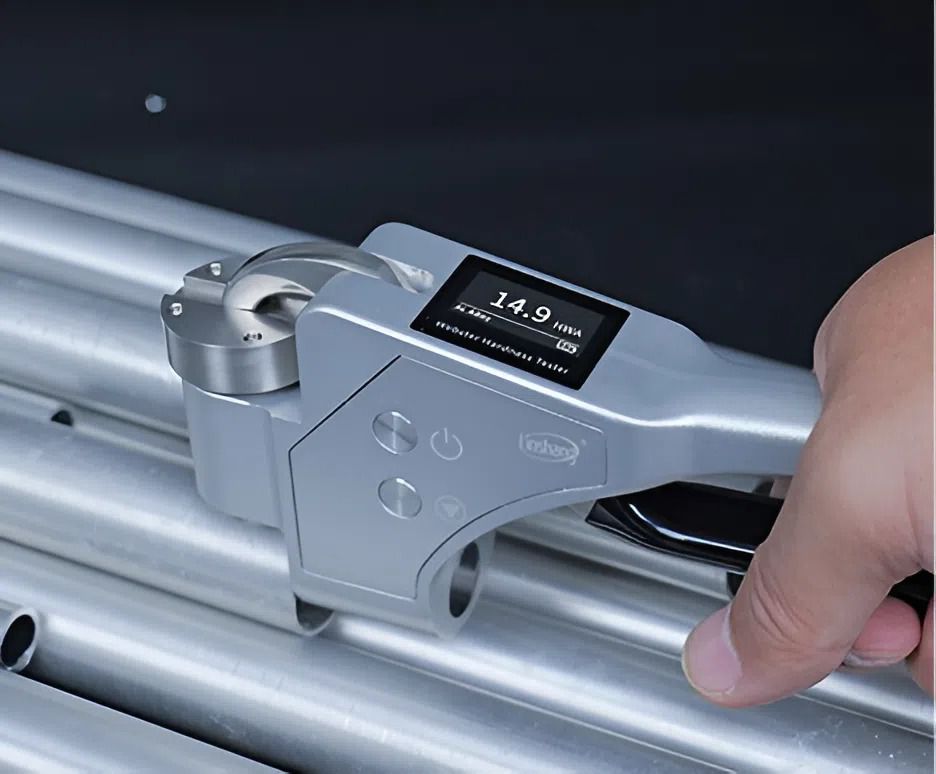Webster Hardness tester
The Technical Realities of Webster Hardness Testers
A Webster hardness tester is a portable measuring device that operates on the indentation principle. However, its accuracy depends on various technical factors, not just the user's operation.

One of the most critical factors is material deformation. When a force is applied to create an indentation, the material can undergo elastic or plastic deformation. A Webster tester measures the depth of the plastic indentation, but if the material is too thin (for example, under 0.6mm), elastic deformation can skew the result. The force from the tester can cause the material to bend, leading to a deeper indentation than what the material's actual hardness would produce. The resulting reading will be lower than the material's true hardness.
To solve this issue, you should use a rigid backing plate beneath the material or stack multiple layers of the material. This increases the sample's overall stiffness, minimizes deformation, and ensures the measurement accurately reflects the material's properties.
Analyzing Common Technical Issues
Besides material thickness, there are two other technical problems that users frequently encounter.
The first is surface condition. Any dirt, oil, or a thin oxide layer on the surface directly impacts the measurement. When the indenter tip comes into contact with a substance that isn't metal, it sinks deeper, causing the hardness reading to drop. To get an accurate result, the sample's surface must be completely clean, using a solvent or fine-grit sandpaper.
The second issue is scale discrepancy. Webster testers often have their own scale, and users typically convert the readings to standard scales like Rockwell (HR) or Brinell (HB) using a conversion chart. It's important to note that these charts are for reference only. The relationship between different scales isn't always perfectly linear, especially with complex alloys. Therefore, for absolute accuracy, using a certified lab-grade hardness tester is essential.
Best Practices for Accurate Operation
To ensure your Webster hardness tester operates effectively and reliably, follow these operational and maintenance principles.
Regular Calibration: Like any measuring instrument, a Webster tester requires periodic calibration using its accompanying standard block. This helps to check for and correct any device drift over time.
Consistent Operation: The force applied when squeezing the handle must be consistent and perpendicular to the sample surface. Inconsistent force can lead to random errors in each measurement.
Data Logging and Analysis: Record measurements from multiple locations on a single sample. Analyze this data to draw conclusions about the material's consistency, rather than relying on a single measurement.
Frequently Asked Questions About Webster Hardness Testers
1. Can a Webster tester measure the hardness of stainless steel?
Yes. There are specific Webster models designed for measuring stainless steel, typically for low to medium hardness grades. You need to check if your tester's model is compatible with the type of stainless steel you are working with. If the steel has been heat-treated and has high hardness, you will need a different type of specialized hardness tester.
2. How do I know if my Webster tester's reading is accurate?
You can compare your results to a standard block. This block comes with the tester and has a certified hardness value. If the reading on the standard block falls within the acceptable range, your tester is functioning correctly.
3. Can I measure the hardness of parts with complex shapes?
Webster testers are designed for measuring on flat surfaces. If a part has a complex shape, you may need to use a custom jig to hold it securely and ensure the tester's indenter tip is always perpendicular to the surface being measured. Without this, the result will not be accurate.
4. Does oil or grease on the surface affect the measurement?
Absolutely. Oil, dirt, or an oxide layer can skew the results. When the indenter pierces these layers, it will sink deeper, causing the hardness reading to appear lower than it actually is. Always clean the sample surface thoroughly before taking a measurement.
5. Is the Webster tester the only tool for on-site material hardness testing?
No. Besides the Webster, there are other types of portable hardness testers, such as Leeb hardness testers (generally used for harder materials) or Barcol hardness testers (used for plastics and composite materials). The choice of tester depends on your material type and accuracy requirements.
-
-
-
-
-
-
-
-
-
-
-
-
-
-
-
-
-
-
-
-
-
-
-
-
